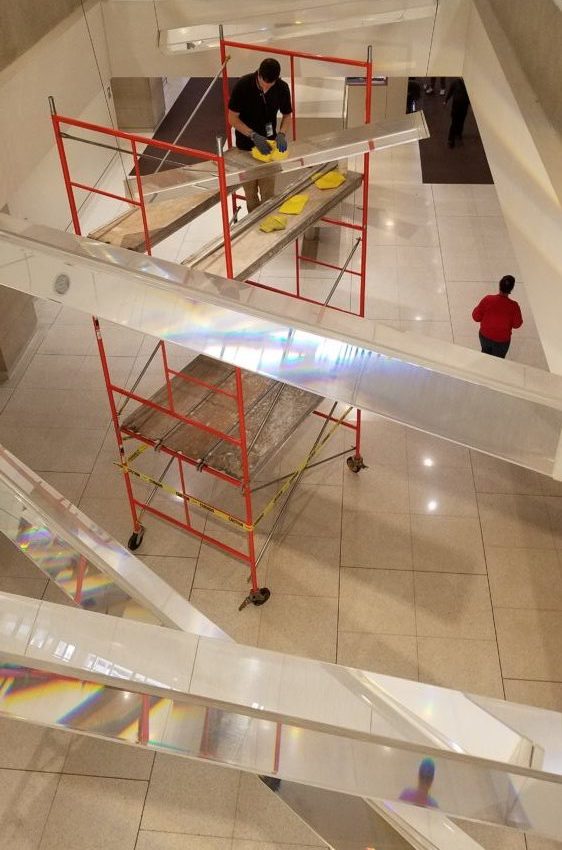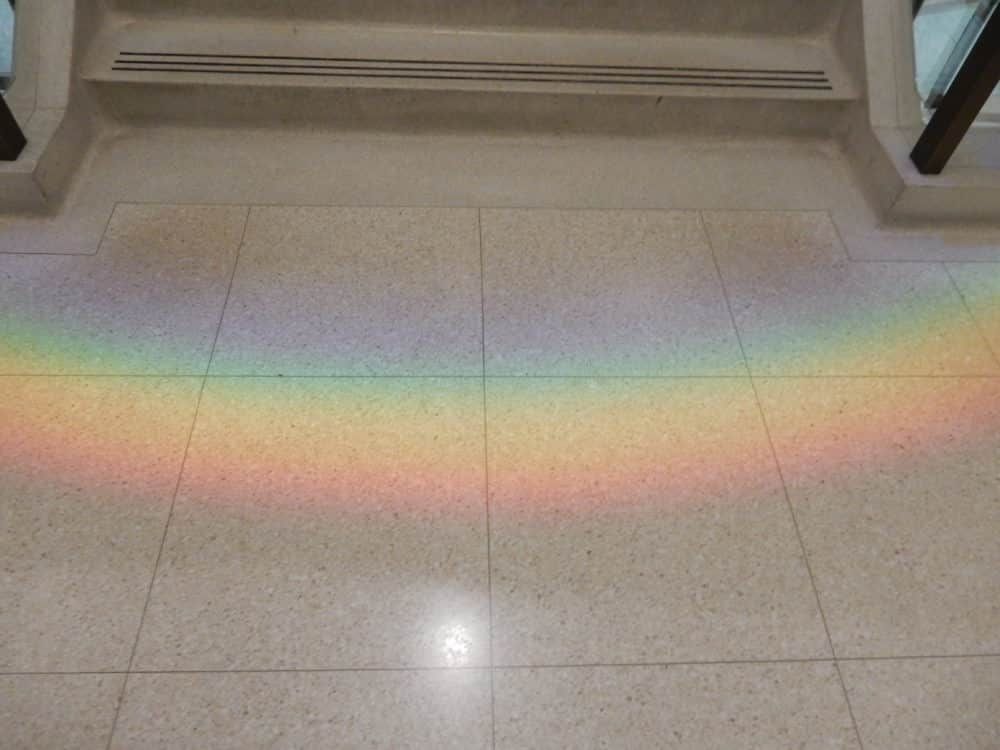Public Art Conservation; Sculpture Conservation:

In the Robert Denney Federal Building in Lincoln, Nebraska, brilliant rainbow-colored bands cascade onto the white interior of the building year round. The source of the light display is an installation, Origin of Color, 1976 by artist Charles Ross. This past December the artwork required some conservation maintenance to restore its full grandeur which was completed by McKay Lodge Conservation.
Ross designed the artwork to capture ambient light to cast soft, solar color onto the surfaces below, also described as a Solar Spectrum installation. The artwork consists of twenty-seven acrylic prisms which are grouped in three separate clusters suspended from the ceiling. Each prism is hollow and filled with mineral oil. They are hung with purpose, methodically placed at precise angles to create the effect. Two theatrical lights located in the stairwell were also installed to cast a “X” shape on the upper staircase.

Origin of Color accumulated some dust over time and other condition concerns that interfered with its intended aesthetic. While conservation treatment of plastic prisms filled with oil is not a typical task, Conservator of Sculpture and Public Art, Jim Gwinner is an expert in contemporary art materials. An on-site examination by Gwinner revealed that the artwork was in good condition with only minor issues consistent with its age. The suspension wires had been discolored by settled dust and grime, appearing black rather than their original silver color. All connections between the prisms and the suspension wires were tight and stable.
The prisms had a slight layer of settled dust on the upward facing surfaces, but they were otherwise clean and free from any damage. Out of the twenty-seven prisms, eight of them exhibited air pockets or bubbles which were present during the original installation. In order to ensure the artist intent was maintained over the years, Gwinner also contacted artist Charles Ross regarding the condition of the Solar Spectrum Installation, Origin of Color.

The treatment entailed general sculpture maintenance. A common Baker scaffolding was erected to access the Solar Spectrum installation. Dust and dirt accumulation was removed with microfiber cloths and a wet cleaning of the acrylic surfaces was performed to clear them and keep the surfaces free of future accumulation. After treatment, surfaces are again able to fully cast light, illuminating the walls, floors, and staircase with ribbons of iridescent color that shift with the seasons and time of day.

Charles Ross realized a passion for art while completing a Bachelors in Mathematics, and then pursued a Masters in Art at the University of California, Berkeley in 1962. Throughout the following decade Ross exhibited work in San Francisco, completed an art fellowship in New York, and taught sculpture at the University of California Berkeley, Cornell University, School of Visual Arts, and Lehman College in New York. He traveled back and forth between New York and California, eventually developing an interest in large prisms. Some of his permanent Solar Spectrum installations are located The National Museum of the American Indian in D.C., Meiji University and Saitama University in Japan, The US Federal Courthouse in Tampa, Florida, and Plaza of the Americas in Dallas.
The installation by artist Charles Ross is not the only art worth visiting off Route 80. There are several art museums in Lincoln, Nebraska such as the Sheldon Museum of Art, Great Plains Art Museum, Midwestern African Museum of Art, and Museum of Nebraska Art (MONA).
